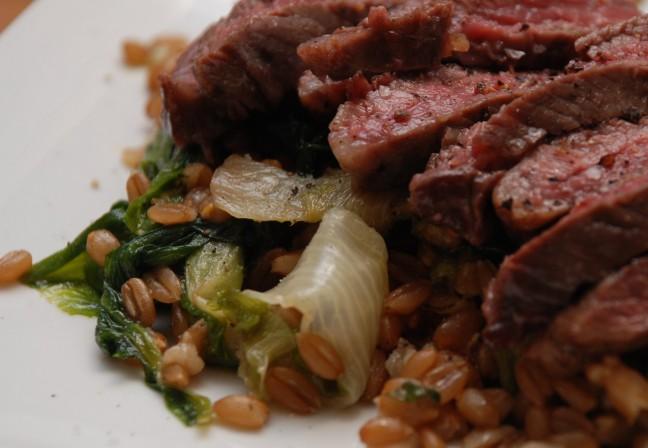We often see it on nutrition labels. We often hear about how many we need in a single day. But what the heck is a “serving size” exactly?
Portion control is important to healthful living because it is a key element of energy balance, or the balance between the amount of calories you take in and burn off in a single day.
As we all know too well, taking in too many calories leads to weight gain, and burning off more than you consume leads to weight loss. You can take some of the guess work out of this delicate balance by knowing and consuming correct portion sizes. Doing so will help you maintain a healthy weight and prevent future chronic disease.
The USDA and the FDA have developed guidelines for single servings of almost all foods commonly eaten in the United States. But what if you, like the majority of Americans, eat almost 50 percent of meals outside the home? Measuring out these portions can be difficult.
How can you “control” your portions if it’s not even clear what one portion is? Luckily, there’s no need to stuff a food scale and a bunch of measuring cups in your backpack to figure it out. The USDA MyPlate (the replacement for MyPyramid) provides guidelines for serving sizes for men and women of different age groups. For our purposes, we will be looking at the recommendations for moderately active men and women ages 19 to 30.
Let’s start with fruit. Both men and women should aim to eat two cups of fruit each day. One cup of some common fresh fruits is equivalent to one large banana (8-9 inches long), an apple the size of a baseball, a large orange, 32 seedless grapes or eight large strawberries. A half cup of dried fruit or eight ounces of fruit juice can also count as a serving.
When it comes to vegetables, the recommended amount differs for men and women. Men should try to consume at least three cups of vegetables a day, and women should shoot for at least two-and-a-half cups. One cup of vegetables is equivalent to 12 baby carrots, a large ear of corn, one medium potato, two large celery stalks, two cups of lightly-packed lettuce or one large bell pepper.
Prefer your fruits and veggies chopped? No problem. One cup of broccoli florets or sliced bananas is roughly the size of a standard baseball. If you’re not a baseball fan, a half cup of chopped fruits or vegetables is about the same size as a standard computer mouse.
For grains, the daily recommendation is eight ounces per day for men and six ounces per day for women. One ounce of grains can be equated to a regular slice of bread, three cups of popped popcorn, two small pancakes or a half cup (computer mouse) of cooked rice or pasta. A large bagel is four ounces of grains, a large muffin is three ounces and a large tortilla (12-inch diameter) is four ounces. Make sure that at least half of these servings are from whole grains.
The daily protein intake is five-and-a-half ounces per day for women and six-and-a-half ounces per day for men. To put this in perspective, two to three ounces of seafood, meat or fish is about the same size as a standard deck of cards. Also, one egg is considered a one-ounce equivalent, while one tablespoon of peanut butter and a half cup of beans or tofu count as two-ounce equivalents.
Three cups of dairy per day are recommended for both men and women. That’s the same as a baseball-sized serving of lowfat yogurt, or eight ounces of milk. One slice of processed cheese counts as one-third cup, and one slice of hard cheese counts as a half cup of dairy.
Finally, oils, which include nut and fish oils, salad dressings and cooking oils, are recommended at six teaspoons for women and seven teaspoons for men in this group. One teaspoon of oil can be viewed as the size of one dice or eight olives. Three teaspoon equivalents is roughly 130 calories worth of nuts, or half of a medium avocado.
It is recommended that the consumption of solid fats such as butter and trans fats be kept to as low a level as possible because they have been linked to high levels of LDL, or “bad” cholesterol.
So now you know the correct portions, but here are some other easy tips to help keep your consumption at the recommended levels:
-
Serve smaller portions to begin with, and put them on smaller plates. Studies show this helps portion control and limits going back for second helpings.
-
When you eat out, only consume half your meal, split a meal with a friend or order an appetizer as an entr?e. Restaurant dishes often contain multiple servings in a single plate.
-
Try not to eat out of a container or package and be aware of packaging sizes. Try to buy the smallest packages possible. We tend to eat more out of bigger packages and less off of dishes.
-
Limit your snacking in front of the TV or while doing other activities. It’s easy to overeat when your mind is elsewhere.
To find out more about the portion sizes of your favorite foods go tomyplate.gov or write to the Low-Fat Tuesday column at [email protected].
One portion of this easy recipe contains one whole serving of fruit, a quarter serving of vegetables, a quarter serving of dairy and one serving of healthy oils!
Easy Fruit Salad
Serves: 4 people
-
1 small red apple, cored and diced
-
1 small green apple, cored and diced
-
1 cup, sliced canned peaches, drained
-
2 stalks of celery, chopped
-
half cup dried cranberries
-
half cup chopped walnuts
-
1 (8 oz.) container of lemon lowfat yogurt
Combine fruit, nuts and dried cranberries in a bowl. Stir in yogurt and serve chilled!



















